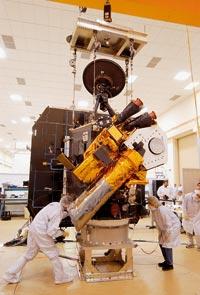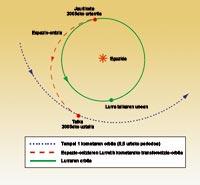Deep impact

In the early 1950s astronomer Fred Whipple proposed that kites were soft snowballs. According to this model, the comets have a solid core and as they approach the Sun, the ice of the core is sublimated and the tail of the comet is formed. The Giotto mission showed that this model is suitable. However, this mission also raised other questions such as why is the kernel albedo so small? Halley's albedo is 4 ei, darker than coal. To answer this question, scientists Mike Belton and Alan Delamare asked NASA to launch a mission that would hit the core of a comet and open a crater. Crater construction allows you to see what is under the dark surface of the core.
The DAP accepted the challenge after several incidents, among which was the change of comet title. On 12 January, a Delta II rocket launched the Deep Impact mission. The mission consists of two modules: the striking and the steering wheel. The impactant weighs 320 kg and will have sufficient manoeuvre autonomy to enter the comet path.

The flyer will be distributed one day before the impact, specifically on July 3, and will hit the target on the day of the American homeland. Meanwhile, the flywheel will observe and record the impact, study the materials extracted from the crater and the structure and composition of the crater. The mission will not end, as it is then that work begins.
Scientists will analyze data collected by Deep Impact over the next nine months. Analyzing the size and depth of the hole made by the impactant, scientists expect signs of the density of the nucleus to exist. After the disappearance of the raised dust, with the help of a camera and a spectroscope, its structure and composition will be analyzed. To see the evolution of impact and collect data, three NASA space telescopes, Chandra, Hubble and Spitzer.

Deep Impact mission.
It might be thought that when the shocking sounds the 9P/Tempel 1 will be affected. That's right, but 767 will be equivalent to what you would notice when a plane hit a mosquito. The shocking hit the kite at a speed of 10.2 km/s. This will reduce the comet speed by 0.0001 mm/s, thus the perihelion distance will be reduced by 10 meters and the orbital period by a second, which is the minimum perihelion distance from the Sun, which revolves around the Sun. For example, when passing the comet near Jupiter in 2024, the perihelion distance will vary by 34 million kilometers due to the gravity of the planet.
Comet 9P/Tempel 1 was discovered in 1967 by astronomer Ernst Wilhelm Tempel. Its orbital period is 5.5 years and spends most of the time
between Mars and Jupiter. The nucleus has an elongated aspect and its approximate dimensions are: 14 x 5 x 5 km.
Why was that kite chosen and not another? There have been several reasons. On the one hand, perihelion is relatively close to the Earth, to 0.9 astronomical units, which allows to access it with relative ease and observe it from the Earth by telescopes. The geometry of the orbit is also very suitable, for example, the angle that will form the comet, the Sun and the probe at the time of the impact will be relatively large, of about 63º, which will cause a considerable sunlight in the yolk. In addition, 9P/Tempel 1 has little activity and dust will not prevent the work of the space probe. Good impact!
Comet Analysis Missions

- 1985. NASA modified the International Sun-Earth Explorer route to fly comet 21P/Giacobini-Zinner and cross the tail. The following year he flew around Halley.
- 1986. It was a lot of boats looking for Halley, the Japanese Giotto of the ESA, Vega 1 and Vega 2 of the USSR and Sakigake and Suisei.
- 1994 That year Comet Shoemaker-Levy 9 hit Jupiter and the Hubble telescope and the Galileo and Ulysses probes analyzed the event.
- 1998. Deep Space 1 portrayed comet 19P/Borrely, best of all.
- 2002. Six weeks after being launched with the Contuor mission, his relationship was lost when he wanted to put himself in the way of hunting the kites.
- 2004 Stardust probe was 236 km from the core of comet 81P/Wild 2. He crossed the inner coma. He obtained representative images.
- 2004 ESA launched Rosetta. In 2014 will launch a scientific package to the surface of comet 67P/Txuriumov-Geramisenko by landing
Answer from Deep Impact

Deep Impact's research focuses on understanding the differences between the surface and interior of a comet's core. Some of the questions you want to answer are:
- If the crater has a depth of 20 m, will the material it contains have carbon monoxide or frozen dioxide?
- Or will water ice still prevail? If it is water ice, will it be a crystalline or amorphous structure?
- At what depth do volatile materials disappear?
- Is the surface old?
- Is the kite structure homogeneous?






